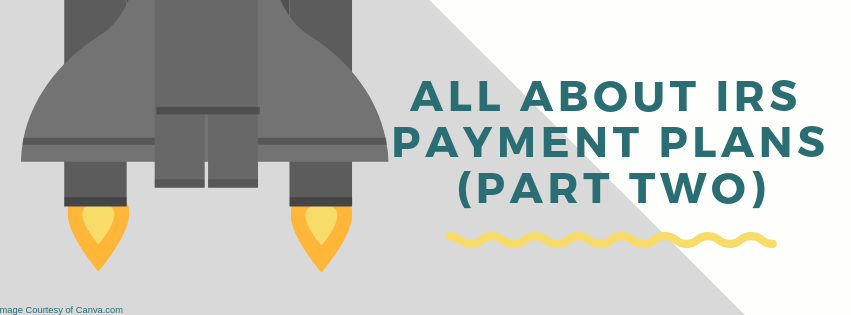With so many tax changes coming into effect this year, countless taxpayers are projected to owe far more taxes than initially expected. But just because your tax due is high doesn’t mean your stress level has to be too.
If you missed it, for those facing a large tax bill, earlier we discussed a few relief options in the form of IRS payment plans, and now we’re back with seven tips on how make the most of those same installation agreements. As a reminder, the payment options are:
Guaranteed Installment Agreements (GIA) – 36 months to pay off debts of $10,000 or less;
Streamlined Installment Agreements (SLIA) – 72 months to pay off debts of $50,000 or less; and
Streamlined Processing – 84 months to pay off debts between $50,000 and $100,000.
1) Dodge a Tax Lien
For taxpayers owing over $50,000, either way you look at it, a tax lien is inevitable. However, this can often be avoided by simply filing for a 120-day extension to pay, and using that time to get the money needed to bring the debts under the $50,000 mark. From there, a SLIA payment plan can be secured and a tax lien avoided.
2) Look at Your “Assessed Balance”
Unlike a GIA or Streamlined Processing plan, an SLIA’s $50,000 threshold counts only the original assessed balance of the taxes, penalties, and interested owed, and not any fees or interest that may accrue over the years after. So, while you’ll still have to pay those extra penalties, they won’t kill your chances of securing an SLIA if your assessed balance is under $50,000.
Not only can this help you secure a better payment plan without a tax lien, but if you’re following the steps of tip #1, you might have even less to pay down to reach that $50,000 mark.
3) Pay Automatically
When IRS payment plans have as high of a default rate as they do, sometimes automatic payments are just easier when any missed payment can be costly for a taxpayer. Plus, as the IRS charges an extra fee for those wishing to pay their debts via check, not only can applying for automatic debit deposits or payroll deductions reduce your monthly costs, but also the amount of paperwork you have to file (and receive in the mail through IRS payment reminders).
4) Avoid Repeat Debts
The second most common reason why IRS plans go into default is because a taxpayer files a following year’s tax return with unpaid debts. To avoid this, taxpayers must make estimated payments throughout the year or change their withholding to prevent going into more tax debt.
5) The One-Payment Grace Period
For most payment plans, the IRS usually allows for one missed payment a year without triggering a default. If you can’t make a payment one month, don’t worry, but definitely notify the IRS in advance of the missed installment and why.
6) Ability-to-Pay Fallback
If through some life crisis your financial situation worsens (such as a lost job or natural disaster), you can always contact the IRS and ask for an Ability-to-Pay plan.
Often requiring documentation of the crisis as well as financial inquiries, if approved under Ability-to-Pay, debts can sometimes be reduced or deferred – though taxpayers should be aware that if found unable to pay debts over $10,000 within 72 months, a tax lien can be issued.
7) Ask for Penalty Abatement
Lastly, once your payment plan is nearing its end, don’t forget to ask for a “failure to pay” penalty abatement – two recommended options being “first-time” abatement or “reasonable cause” abatement if applicable.
Often many who owe tax get into the situation because they didn’t have their information ready to file their tax returns on time. If you need help with your bookkeeping, we’d love to help and can be reached at [email protected] or (310) 534-5577.
